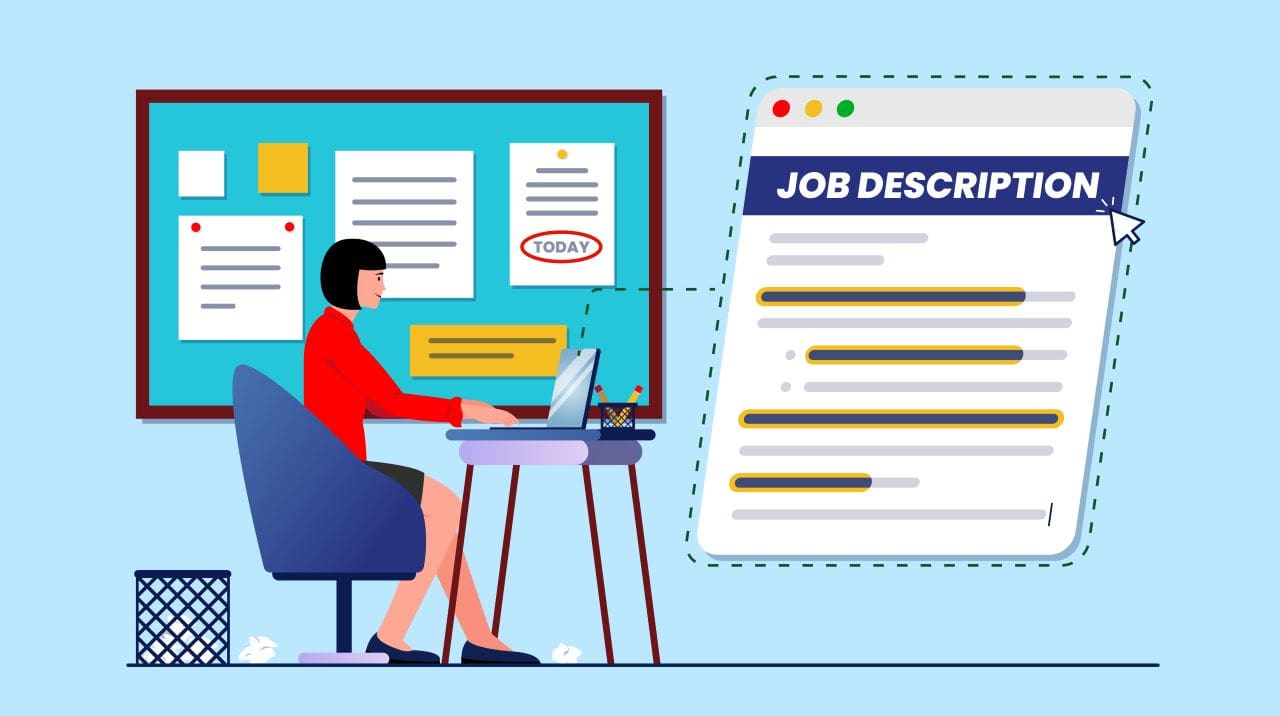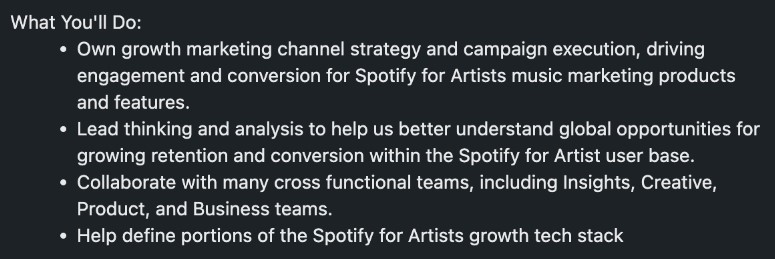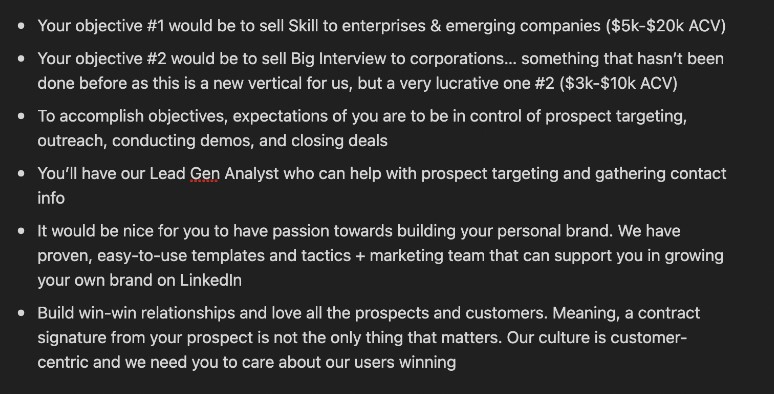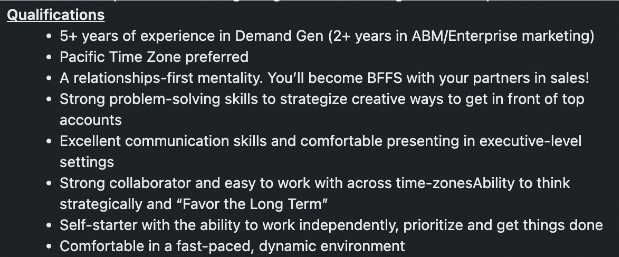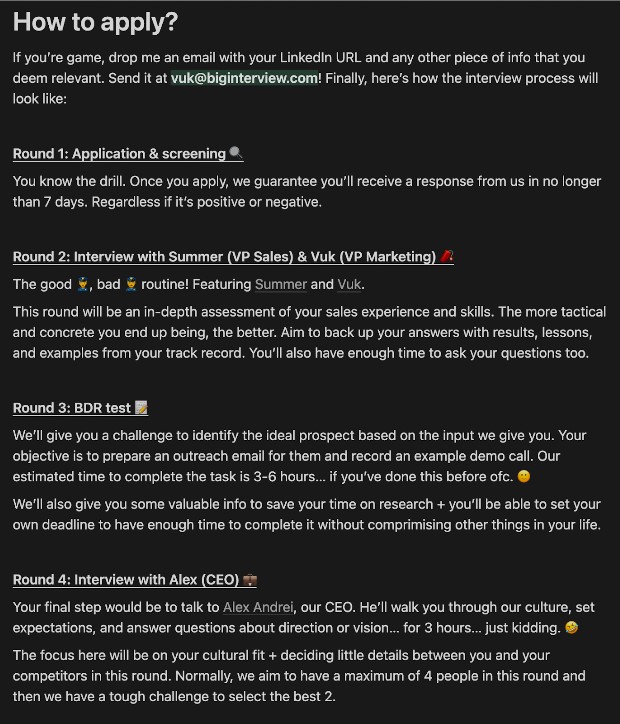Understanding how to write job descriptions is one of the keys to getting more great job applications. Especially if you don’t have a big brand and it’s hard to stand out, an attractive job post can make a big difference.
But if you can master the 6 steps below, you’ll end up having not more candidates, but more qualified candidates instead.
This article will analyze successful job description examples and why they work. You’ll also get the ultimate job template for free, which will save you hours and help you systemize the creation process.
4 Challenges with Writing Job Descriptions
Generally speaking, no single type of content is as unified as job posts. It almost feels like everyone is using the same template.
Most hiring managers and recruiters often face these 4 challenges when writing job descriptions:
- They don’t resonate with candidates
- They don’t understand how to make their job ads stand out
- They’re failing to receive more applications in the first place
- They aren’t happy with the quality of candidates they’re getting
If any of these sounds like something you’re going through, read on.
As a marketer, I’ve written a bunch of job descriptions. And I always had the same challenge. How to write job descriptions that motivate the right people to apply? Even if we’re not a famous company, how can we make our job ads different?
After hiring 27 people and building 3 teams so far, I finally cracked it. That’s why you’ll see proven tactics below that took me years to figure out.
Plus, I’ve prepared a special surprise at the end that will help you streamline the creation of attractive job descriptions.
Let’s dive in.
How to Write Job Descriptions in 6 Steps
A 6-step action plan to write better job descriptions coming next, starting with…
Step 1: Crafting the teaser sentence
Before listing bullet points about the job, we need to think about our teaser sentence.
In other words, how can we craft that one intriguing line that catches their attention and makes candidates excited about the job?
Let’s take a look at a few examples of good teaser sentences.
I love how Spotify approached this one. The first sentence immediately sets the tone regarding the profile they’re looking for. Afterward, they jumped into portraying the ABCs of the role. Finally, the last sentence sounds exciting and inspiring.
This example is a standard best practice that reputable brands and established companies leverage to hire top talent.
Here’s another one by Webflow.
You’ll see some companies starting their job posts with a quick intro about their company’s mission. I like how Webflow did it in one sentence instead of a long paragraph. Plus, they’re playing directly on their candidate’s ambition, outlining the key challenges.
The final example comes from me so I can put my money where my mouth is.
Starting off with a question is a good choice because it builds intrigue. On top of that, the “doing it the right way” part is there for a reason. The idea is to explain that we want to play the Social Media game the right way, which consists of treating it like a marathon and not a 2-month lead gen channel.
With a little humor at the end, this is a brief 3-sentence mix that aims to attract specific types of candidates to apply.
Step 2: Tell them about your company
If you prefer to give details about your company in the intro, skip this step.
Alternatively, you could do this. Have a dedicated section to share a word or two about the company and its mission. Of course, the popularity of your company’s name and the complexity of its products might dictate how you approach this section.
Here’s how I tackle this challenge.
Keeping it short and sweet! Also, giving people links to seek additional info makes their life simpler, but it also allows me to see in the next round which candidates did their research. Mentioning we’re bootstrapped and profitable is also done with intent, considering the economy right now and the popularity of the bootstrapped momentum.
General advice? Don’t write an essay. Be straightforward, but inspiring. Consider moving people to your career page to find out more or adding a cool video in this section.
Whether you place the “About the company” section higher or lower, is not as important.
Step 3: Explain the role
Here’s what you shouldn’t do:
- Be too broad and vague about key responsibilities
- Write job descriptions for senior profiles that show a lack of direction
- List responsibilities that would take an army to execute
It’s easy to copy/paste someone else’s job summary in an effort to publish it fast. Although I am a big fan of borrowing tactics from successful people, you should also adapt content to your audience. Add authenticity because it works best.
The objective of this section is to:
- Show the company’s ambition and what they want to do next
- Show that the company knows exactly who they’re looking for
- Intrigue the right candidates and make it easier for you to screen them
Take a look at Spotify’s post for Growth Marketer again.
Pretty direct and straightforward. Also, speaking as a Growth Marketer myself, sounds like an exciting challenge too.
Here’s another example of a role we’re actively searching for. Btw, if you are a driven BDR yourself, we need you.
There are different types of BDRs. Those who specialize in prospecting and those who operate as full-stack Sales Devs. Are you looking for closers or for people who are passionate about nurturing the relationship after the contract has been signed?
It’s these little details and how you outline them that will increase the quality of candidates you’ll receive.
Step 4: Define MUSTs & NICE-to-haves
‘Who you are’, ‘Expectations’, ‘Must have’, ‘Key qualifications’… how you name this section is not the most important thing to worry about.
Must-have skills and personality traits serve more as an add-on to the previous section where you listed job specifications.
To simplify, the goal is to tell the candidate about the skills they’ll need to crush this role.
You saw an example from Gong above, who is looking for an Account-Based Marketing Manager. You can see how they are playing to the soft skills and mentality of the person.
Sometimes, you’ll see recruiters and hiring managers adding a “Nice to have” section as well. In most cases, it represents a list of skills that would be a plus for the candidate, but they’re not a deal breaker.
Being an operator in the startup world, I’ve borrowed a trick from one of my ex-bosses: make nice-to-have sections entertaining.
Back then, we were saying it would be nice if you are a fan of ‘The Office’ and ‘Friends’ TV shows, as we’re quoting them all day long. We even recreated the Friends intro for employer branding purposes and got great feedback for it. You can check it out here.
Being a bit different and not always too serious… it’s human and fun. Not a bad deal!
Step 5: What’s in it for the candidate
Super important section… obviously.
Considering how competitive the demand for talent is, most of us know what candidates want:
- Competitive salaries
- Ability to customize contracts depending on location
- Remote work options
- Health, parental leave, etc.
- Personal growth opportunities
For instance, not offering a ‘work from anywhere’ policy is a bad idea that will make it twice as hard to attract candidates.
But for those of us offering similar benefits to employees, the key here is how you present them + what type of reputation you have online (reviews, employee advocacy, branding).
The strategy that generated good results for me in the past is turning this section into a story and making it more human. You can see an example here. Just scroll down to the section called ‘What’s in it for you’.
Step 6: Explain the hiring process
Last but not least, add a section that quickly explains your hiring process and what the next steps are.
If you don’t do this, you’ll have to explain it in each interview separately. Since I’m not an aficionado of repeating myself, I wanted to use this time for something better and motivate candidates to ask more creative questions.
Therefore, I always explain how we roll.
Keep in mind that if you have any special requests to ask your applicants, make sure to mention them in this section.
Steal This High-Performing Job Template
If you’ve been staring at the blank page for too long or you’re fed up with job descriptions that are not working, give this template a shot.
My goal was to give you an actionable job post template and speed up the process of creating it.
Bottom Line
There you have it. How to write a good job description for LinkedIn or any other platform is, hopefully, not that big of a challenge anymore.
Btw, if you’re interested, we’re also building a community for curious recruiters and hiring managers who want to build great teams. The main value for you? Access to loads of cool resources + the ability to have real talks and borrow best practices from other practitioners.
If you’re game, join our community today.
Hope this helps! Happy recruiting,
Vuk
